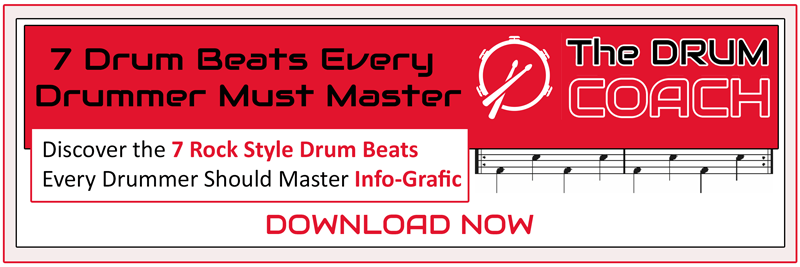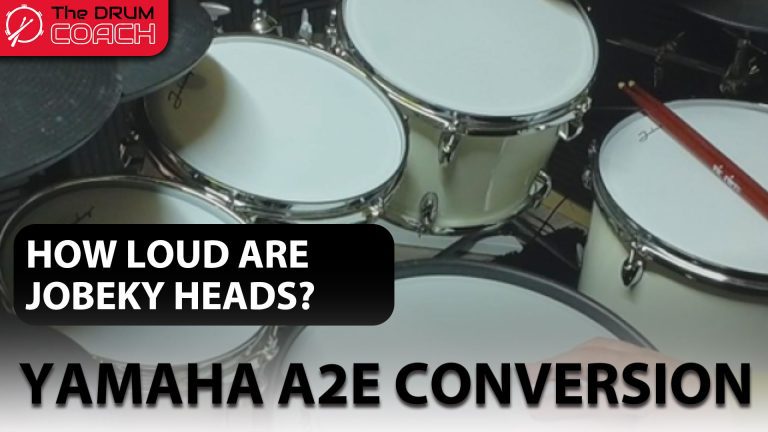Precise and Relaxed Drumming Technique
When it comes to drumming, playing tight and with precision are great attributes. After all, the drummer’s job is to keep time and provide a solid and precise foundation for the rest of the band. While that’s certainly true, there’s also a time and a place for playing loose, with a relaxed drumming technique.
In fact, playing loosely can be just as important as playing tight and precise. Especially when it comes to genres like jazz, funk, and more contemporary music. So how do you do that?
Playing with a relaxed drumming technique starts with the drummer being relaxed. What the drummer feels will be transferred into the drumming producing a not so relaxed drumming technique and playing style. Start by holding the sticks as you normally would, and then just loosen the grip. Let the sticks float in your hands. Playing loose is then just a simple matter of continuing this technique. And then tighten the grip when you want to play something more solid and specific.
Whilst the volume and environment you are playing in have an impact. And in some cases can negate what you’re trying to do completely. Let’s presume that the environment is evenly balanced. Giving rise to actually being able to hear the difference between playing tight. And playing in a more carefree and loose fashion.
With that in mind here are some tips to take into account.
Tip 1: Use Your Timekeeper Function
The first and most important tip is to remember that your primary function as a drummer is to keep time. This means that even when you’re playing loosely, you still need to maintain a solid pulse.
One way to do this is to focus on using your timekeeper function. This means keeping your foot on the hi-hat pedal and using that as a reference point for the rest of your limbs. By keeping one limb steady, you’ll have an anchor that will help you stay in time. Even when the rest of your body is moving around.
And bear in mind that the hi-ht pulse can also be played tight and crisp or free and loose. Depending on the piece of music you’re playing at the time. It doesn’t always have to be tight and crisp all the time.
Having decided whether the hi-hat is played loose. Or it becomes loose within a particular song section. You proceed to play the piece in the chosen fashion. Which of course, is a decision you will have to make based on what you are hearing from the other musicians. As well as the overall atmosphere of the music being played. Or, the effect you want to create.
 This is then a dynamic decision based on the dynamics you are looking to create at any one time. Read the dynamic drumming post to further enhance the looseness concept.
This is then a dynamic decision based on the dynamics you are looking to create at any one time. Read the dynamic drumming post to further enhance the looseness concept.
Tip 2: Don’t Overthink It
In all these dynamic decisions, it’s important not to overthink things. Feel it instead. When you’re playing loosely, it’s important to go with your gut and not get too caught up in what you’re doing. Impulsiveness is key. If you start overthinking things, you may end up tense and tight.
Which is the opposite of what you’re going for. So take a deep breath, relax, and let your body move the natural way that it wants to.
Whilst remaining under your control of course.
Tip 3: Listen to the Music
Last but not least, make sure you’re listening to the music. This might seem like an obvious point, but it’s important nonetheless. When you’re playing loosely, it’s easy to get lost in your own world and lose track of what’s going on around you. But if you want to stay in time and in sync with the rest of the band, you need to be listening at all times. Pay attention to the other instruments and let their groove guide your own playing.
As well as the staccato level within their playing. Often this will require loosening up followed by tightening up very soon after.
Often a heavy type rock tune is enhanced by loose playing. I mean to say when you’re really pushing the beat forward with the rest of the band. Playing loose hi-hats along with the solid (but loose) bass drum and snare techniques can really make the music. To take advantage of this you need to recognize when the song or beat needs pushing. And then put your heart behind it as you push the music forward.
Listen To Yourself
With all this in mind. Listen to some rock drummers on the internet. Don’t get me wrong, there are some awesome technicians. But, listen to the dynamics within their drumming. Almost everything is monotonal. In most cases the drumming is flat. It’s complex, I will give them that, but then it can be plain boring to listen to. Unless you’re into that kind of heavy drumming that is.
In other words, it’s not musical. But hey, if you’re into that then listen to yourself. You can still appreciate someone else’s art and pick fault with it too. It all helps to make you better, or at the least to develop your own style. So long as you don’t get too judgy.
 Many of those drummers I speak of could blow me out of the water on a technical level. what they do is just not my thing. But I still appreciate their playing.
Many of those drummers I speak of could blow me out of the water on a technical level. what they do is just not my thing. But I still appreciate their playing.
Long story short. Listen to yourself and what you like then stick with that. And know that there’s nothing wrong with learning new approaches. Even if they are miles away from your own style and taste.
Additional Thoughts On Playing Loosely On Drums
Playing loosely on the drums can be a great way to add some creativity and spontaneity to your playing. But it’s important to remember that even when you’re playing loosely.
You still need to maintain a solid pulse and listen to the music.
Relaxed Drumming Techniques for a Better Beat
In addition to playing loose, it’s important to stay relaxed. Not playing with a relaxed drumming technique defies the objective of playing loose drumming. Tension in your muscles not only affects the quality of your sound. It can also lead to uncomfortable cramping and even injuries if left untreated. So let’s go over some easy ways to relax your body and mind while you’re playing the drums.
- First, take a seat at your drum set and get comfortable. Make sure your back is straight and that you can reach all the drums and cymbals within arm’s reach. If you need to adjust your seat or stool, do so now. Once you’re seated comfortably, take a few deep breaths and close your eyes. Picturing yourself in a peaceful setting can help to relax your mind and body. Then focus on what you are going to be playing.
Whilst you are playing. Be mindful of your breath. Breathe as you play. Then it’s also important to keep your back straight. This will help you focus and breathe easier. As your central nervous system doesn’t get squashed up against your spinal column. This again promotes easy breathing and better focus. See the posture post on this site and review the Alexander Technique.
- Begin by tapping the drum in front of you. Use both hands so that you don’t favor one side more than the other. As you tap, focus on keeping your wrists loose and flexible. Don’t so much care about what you’re playing. Keep the focus on your bodily movements. You should feel as though the sticks are floating between your fingers. Rather than being gripped tight.
- After a minute or so of light tapping, or floating. Start to increase the power/volume slightly so that you can feel the vibration in your hands as you play. Again, be sure to use both hands so that one side doesn’t become more dominant than the other. You may also want to experiment with different parts of the drum surface. To create different sounds.
All this involves what I call floating around the kit. Because you aren’t really gripping the sticks. They’re just floating between your fingers and then you control the drums you hit. All the time being relaxed of course. No force is being applied.
- Once you’re comfortable with varying degrees of power and vibration. It’s time to start using both sticks around the whole kit as implied in the last few lines. Float around the kit as you strike the drums. In other words, don’t hit them, play them.
As soon as I am able I will create a video t demonstrate exactly what I mean. The point is that you play everything from this standpoint. This perspective of floating loosely around the kit.
- As you become more comfortable with using both sticks. Try experimenting with different strokes such as single strokes, double strokes, or paradiddles. Also, try different beats. Remember to keep your grip loose and your wrist flexible so that you don’t strain yourself.
As I suggested elsewhere. I like to think of this as Bruce Lee would suggest. Playing without playing.
- If at any point during your playing you start to feel the tension in your muscles. Take a brief break and shake out your arms and legs. Or play the movements whilst not hitting the drums so purposely. which is actually the point anyway.
It’s important not to overdo it when you first start practicing these techniques. They’re not practical par se, but they will transfer over to your drumming later. And as with anything else, it takes time for your body to adjust and get used to. And in most cases, you will just want to hit harder. If that’s your thing. But try to avoid this if possible.
By following these simple practice tips, you will be playing drums in a relaxed and precise way in no time. With time and practice, you may even find that you have an improved sense of rhythm and dynamics as well as playing most of the time with a relaxed drumming technique.
Conclusion
Of course, it goes without saying that you can also take part in relaxation exercises. Yoga or meditation and so on. But this isn’t the time to go into those things. And as you practice this technique, drift into your playing and increase the tightness as you play. Then let it off again as you see fit.
So, what are your tips on relaxing whilst playing? Do you do any particular form of relaxation exercises on or off the drums? Let us know in the comments below. And let’s just chill together and become better drummers to boot.




